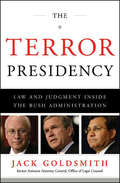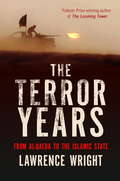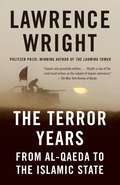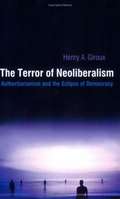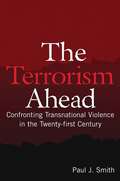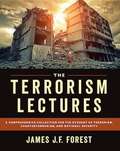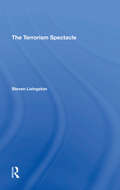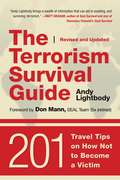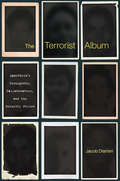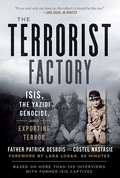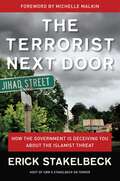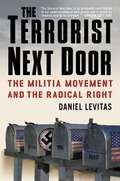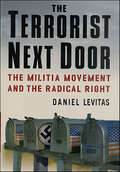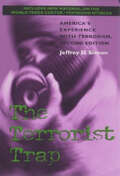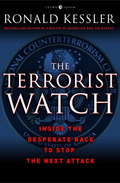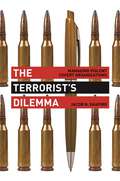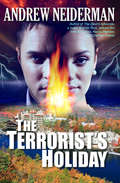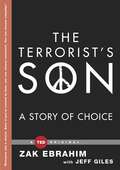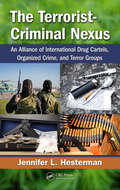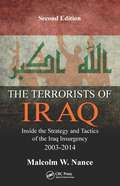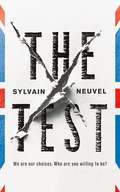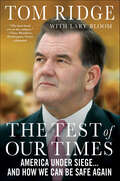- Table View
- List View
The Terror Presidency: Law and Judgment Inside the Bush Administration
by Jack GoldsmithA central player's account of the clash between the rule of law and the necessity of defending America. Jack Goldsmith's duty as head of the Office of Legal Counsel was to advise President Bush what he could and could not do...legally. Goldsmith took the job in October 2003 and began to review the work of his predecessors. Their opinions were the legal framework governing the conduct of the military and intelligence agencies in the war on terror, and he found many--especially those regulating the treatment and interrogation of prisoners--that were deeply flawed. Goldsmith is a conservative lawyer who understands the imperative of averting another 9/11. But his unflinching insistence that we abide by the law put him on a collision course with powerful figures in the administration. Goldsmith's fascinating analysis of parallel legal crises in the Lincoln and Roosevelt administrations shows why Bush's apparent indifference to human rights has damaged his presidency and, perhaps, his standing in history.
The Terror Years: From al-Qaeda to the Islamic State
by Lawrence WrightTen powerful pieces first published in The New Yorker recall the path terror in the Middle East has taken from the rise of al-Qaeda in the 1990s to the recent beheadings of reporters and aid workers by ISIS. With the Pulitzer Prize-winning The Looming Tower, Lawrence Wright became generally acknowledged as one of our major journalists writing on terrorism in the Middle East. This collection draws on several articles he wrote while researching that book as well as many that he's written since, following where and how al-Qaeda and its core cult-like beliefs have morphed and spread. They include an indelible impression of Saudi Arabia, a kingdom of silence under the control of the religious police; the Syrian film industry, then compliant at the edges but already exuding a feeling of the barely masked fury that erupted into civil war; the 2006-11 Israeli-Palestinian conflict in Gaza, a study in disparate values of human lives. Others continue to look into al-Qaeda as it forms a master plan for its future, experiences a rebellion from within the organization, and spins off a growing web of terror in the world. The American response is covered in profiles of two FBI agents and a chief of the CIA. It ends with the recent devastating piece about the capture and beheading by ISIS of four American journalists and aid workers, and how the US government failed to handle the situation.
The Terror Years: From al-Qaeda to the Islamic State
by Lawrence WrightWith the Pulitzer Prize-winning The Looming Tower, Lawrence Wright became generally acknowledged as one of our major journalists writing on terrorism in the Middle East. Here, in ten powerful pieces first published in The New Yorker, he recalls the path that terror in the Middle East has taken, from the rise of al-Qaeda in the 1990s to the recent beheadings of reporters and aid workers by ISIS. The Terror Years draws on several articles he wrote while researching The Looming Tower, as well as many that he's written since, following where and how al-Qaeda and its core cultlike beliefs have morphed and spread. They include a portrait of the "man behind bin Laden," Ayman al-Zawahiri, and the tumultuous Egypt he helped spawn; an indelible impression of Saudi Arabia, a kingdom of silence under the control of the religious police; the Syrian film industry, at the time compliant at the edges but already exuding a feeling of the barely masked fury that erupted into civil war; the 2006-11 Israeli-Palestinian conflict in Gaza, a study in the disparate value of human lives. Other chapters examine al-Qaeda as it forms a master plan for its future, experiences a rebellion from within the organization, and spins off a growing web of worldwide terror. The American response is covered in profiles of two FBI agents and the head of the intelligence community. The book ends with a devastating piece about the capture and slaying by ISIS of four American journalists and aid workers, and our government's failed response. On the fifteenth anniversary of 9/11, The Terror Years is at once a unifying recollection of the roots of contemporary Middle Eastern terrorism, a study of how it has grown and metastasized, and, in the scary and moving epilogue, a cautionary tale of where terrorism might take us yet. From the Hardcover edition.
The Terror of Neoliberalism: Authoritarianism and the Eclipse of Democracy
by Henry A. GirouxContending that it threatens the very foundation of democracy by deterring public participation, cultural critic Giroux examines neoliberalism both as a cultural politics and a public pedagogy. His wide-ranging analysis reveals how this type of market fundamentalism exacerbates class, racial, and gender inequalities. The volume concludes with reflections on Edward Said's legacy of resistance. Giroux (communications, McMaster U.) is the author of numerous books, including The Mouse that Roared (1999). Annotation ©2004 Book News, Inc., Portland, OR (booknews.com)
The Terrorism Ahead: Confronting Transnational Violence in the Twenty-First Century
by Paul J. SmithThis book examines the evolving threat of terrorism and draws on the latest research to assess future trends. The author assumes that terrorism will remain a potent threat to the international system throughout the twenty-first century, primarily because of the convergence of two negative trends: the availability of Chemical, Biological, Radiological, and Nuclear Weapons (CBRN) - also known as Weapons of Mass Destruction - and the proliferation of terrorist organizations seeking to achieve mass casualties. Even without the CBRN element, however, Smith maintains that terrorism will remain an ongoing threat. The book also explores specific aspects of contemporary terrorism, including political, social, economic, religious, and ideological factors, globalization as a stimulation to contemporary terrorism, the role of organized crime in terrorist movements, and more. Written with students in college and professional programs in mind, the book includes case studies interspersed throughout the chapters that provide clarifying examples.
The Terrorism Lectures
by James ForestThe authoritative compendium for students of terrorism and counterterrorism.
The Terrorism Spectacle
by Steven LivingstonHow terrorism is portrayed by the news media, and thus perceived by the public, is directly linked to government's foreign policy goals. Steven Livingston demonstrates the complex interactions among the press, the public, and political actors in illuminating a policymaking process that relies on image management as one strategy in achieving policy objectives–not just in combating terrorism but also in handling other foreign policy problems.
The Terrorism Survival Guide: 201 Travel Tips on How Not to Become a Victim, Revised and Updated
by Andy LightbodyThe age of carefree travel is over. The threats of criminal acts and of terrorism, both internationally and domestically, are an all-too-common reality. Last year saw more than fourteen thousand terrorist incidents across the globe—it’s no wonder that people are frightened when they are away from home.The Terrorism Survival Guide: 201 Travel Tips on How Not to Become a Victim can help take away that fear. The book is an easy-to read pocket guide with hundreds of tips that help take away the worry of business and vacation travels. These tips are designed for everyone and cover a wide range of topics:Staying safe at airportsHow to protect your luggage“Low profile” tourismTraveling with childrenWhat to do if capturedIn addition to travel tips, the book gives contact information for US embassies and consulates worldwide, US Customs information, State Department terrorism updates, and TSA guidelines. The Terrorism Survival Guide will make you a wiser, smarter, and safer traveler.
The Terrorism Trap: How the War on Terror Escalates Violence in America's Partner States (Columbia Studies in Terrorism and Irregular Warfare)
by Harrison AkinsAfter two decades and trillions of dollars, the United States’ fight against terrorism has achieved mixed results. Despite the vast resources and attention expended since 9/11, terrorism has increased in many societies that have been caught up in the war on terror. Why have U.S. policies been unable to stem the tide of violence?Harrison Akins reveals how the war on terror has had the unintended consequence of increasing domestic terrorism in U.S. partner states. He examines the results of U.S.-backed counterterrorism operations that targeted al-Qaeda in peripheral regions of partner states, over which their central governments held little control. These operations often provoked a violent backlash from local terrorist groups, leading to a spike in retaliatory attacks against partner states. Senior U.S. officials frequently failed to grasp the implications of the historical conflict between central governments and the targeted peripheries. Instead, they exerted greater pressure on partner states to expand their counterterrorism efforts. This exacerbated the underlying conditions that drove the escalating attacks, trapping these governments in a deadly cycle of tit-for-tat violence with local terrorist groups. This process, Akins demonstrates, accounts for the lion’s share of the al Qaeda network’s global terrorist activity since 2001.Drawing on extensive primary sources—including newly declassified documents, dozens of in-depth interviews with leading government officials in the United States and abroad, and statistical analysis—The Terrorism Trap is a groundbreaking analysis of why counterterrorism has backfired.
The Terrorist Album: Apartheid’s Insurgents, Collaborators, and the Security Police
by Jacob DlaminiAn award-winning historian and journalist tells the very human story of apartheid’s afterlife, tracing the fates of South African insurgents, collaborators, and the security police through the tale of the clandestine photo album used to target apartheid’s enemies. From the 1960s until the early 1990s, the South African security police and counterinsurgency units collected over 7,000 photographs of apartheid’s enemies. The political rogue’s gallery was known as the “terrorist album,” copies of which were distributed covertly to police stations throughout the country. Many who appeared in the album were targeted for surveillance. Sometimes the security police tried to turn them; sometimes the goal was elimination. All of the albums were ordered destroyed when apartheid’s violent collapse began. But three copies survived the memory purge. With full access to one of these surviving albums, award-winning South African historian and journalist Jacob Dlamini investigates the story behind these images: their origins, how they were used, and the lives they changed. Extensive interviews with former targets and their family members testify to the brutal and often careless work of the police. Although the police certainly hunted down resisters, the terrorist album also contains mug shots of bystanders and even regime supporters. Their inclusion is a stark reminder that apartheid’s guardians were not the efficient, if morally compromised, law enforcers of legend but rather blundering agents of racial panic. With particular attentiveness to the afterlife of apartheid, Dlamini uncovers the stories of former insurgents disenchanted with today’s South Africa, former collaborators seeking forgiveness, and former security police reinventing themselves as South Africa’s newest export: “security consultants” serving as mercenaries for Western nations and multinational corporations. The Terrorist Album is a brilliant evocation of apartheid’s tragic caprice, ultimate failure, and grim legacy.
The Terrorist Factory: ISIS, the Yazidi Genocide, and Exporting Terror
by Father Patrick Desbois Nastasie Costel Lara LoganA riveting, behind-the-scenes look of the Yazidi genocide and the terrorist threat it holds for the West, based on the investigation by Father Patrick Desbois, Costel Nastasie, and their team at Yahad–In Unum, as first shown on 60 Minutes. With testimony drawn from more than 200 interviews with Yazidi survivors—girls, women, boys, and men—recorded during 11 investigative trips to refugee camps in Iraqi Kurdistan. "If you read only one book on this subject, it should be this one.”—Lara Logan, 60 Minutes The massacre of the Yazidi people by ISIS was nothing less than genocide. In refugee camps in Iraqi Kurdistan, the authors brought a skilled team to interview more than a hundred ISIS survivors and document what they experienced and saw. These former slaves observed their torturers and know from the inside the secret facilities that ISIS has kept hidden from the world. What their testimony reveals is an organization whose ambition is power, regardless of their claim to be "soldiers of God." Their fighters are paid with sex, money, and the power of life and death over captives. Their promised paradise is here and now, not after death. Men who didn't swear allegiance were executed. Women became slaves for sex or reproduction, and their offspring may still serve the cause. In mobile training camps, the captured children were drugged, indoctrinated, and taught to shoot Kalashnikovs, plant explosives, and handle suicide vests. They are the intended products of the terrorist factory. In this taut, disturbing account, the authors document a utilitarian genocide that still holds an implicit threat to other counties, including those in the West.
The Terrorist Next Door: How the Government is Deceiving You About the Islamist Threat
by Erick StakelbeckAl-Qaeda doesn't care about "Hope" and "Change"The threat of terrorism in America, the Obama administration assures us, is contained and controlled. Recent attempted attacks like the Times Square bombing, the "underwear bombing" on a flight over Detroit, and the attack on a Christmas tree lighting ceremony in Oregon were all isolated plots that failed anyway. In the words of Homeland Security secretary Janet Napolitano, "The system worked."Don't believe it. In The Terrorist Next Door, investigative reporter Erick Stakelbeck exposes the staggering truth about our national security: the Obama administration is concealing and whitewashing the enormous terrorist threat growing right here within America's borders. If you believe terrorism is only a problem for other countries, Stakelbeck's on-the-ground reporting will open your eyes. He has been inside America's radical mosques, visited U.S.-based Islamic enclaves, and learned about our enemies by going straight to the source--interviewing al-Qaeda-linked terrorists themselves. In this shocking book, Stakelbeck reveals:How Islamic radicals have established separatist compounds and even jihadist training camps throughout rural AmericaThat an overt disciple of Iran's Ayatollah Khomeini now leads one of the largest mosques in America How mega-mosques aren't just planned for Ground Zero--they're being built in the heart of the Bible Belt as part of a plan for Islamic dominationWhat a former U.S. covert agent inside the Iranian regime says about Iran's program to recruit Americans into terror groupsHow the Obama administration's beguiling counter-terrorism policies are increasing the threat of another 9/11 The Terrorist Next Door sounds the alarm on a growing threat to every American--one that the U.S. government refuses to face honestly or even to name. As we struggle against a relentless and adaptable Islamist enemy that is committed to destroying our nation, we can't say we weren't warned.
The Terrorist Next Door: The Militia Movement and The Radical Right
by Daniel LevitasWritten by Daniel Levitas, a national expert on the origins and activities of white supremacist and neo-Nazi groups, The Terrorist Next Door is painstakingly researched and includes rich detail from official documents (including the FBI), private archives and confidential sources never before disclosed. In detailing these and other developments, The Terrorist Next Door will prove to be the most definitive history of the roots of the American militia movement and the rural radical right ever written.
The Terrorist Next Door: The Militia Movement and the Radical Right
by Daniel LevitasSeptember 11, 2001, focused America's attention on the terrorist threat from abroad, but as the World Trade Center towers collapsed, domestic right-wing hate groups were celebrating in the United States. "Hallelu-Yahweh! May the WAR be started! DEATH to His enemies, may the World Trade Center BURN TO THE GROUND!" announced August Kreis of the paramilitary group, the Posse Comitatus. "We can blame no others than ourselves for our problems due to the fact that we allow ...Satan's children, called jews (sic) today, to have dominion over our lives." The Terrorist Next Door reveals the men behind far right groups like the Posse Comitatus - Latin for "power of the county" -- and the ideas that inspired their attempts to bring about a racist revolution in the United States.Timothy McVeigh was executed for killing 168 people when he bombed the Alfred P. Murrah Federal Building in 1995, but The Terrorist Next Door goes well beyond the destruction in Oklahoma City and takes readers deeper and more broadly inside the Posse and other groups that comprise the paramilitary right. From the emergence of white supremacist groups following the Civil War, through the segregationist violence of the civil rights era, the right-wing tax protest movement of the 1970s, the farm crisis of the 1980s and the militia movement of the 1990s, the book details the roots of the radical right. It also tells the story of men like William Potter Gale, a retired Army officer and the founder of the Posse Comitatus whose hate-filled sermons and calls to armed insurrection have fueled generations of tax protesters, militiamen and other anti-government zealots since the 1960s.Written by Daniel Levitas, a national expert on the origins and activities of white supremacist and neo-Nazi groups, The Terrorist Next Door is painstakingly researched and includes rich detail from official documents (including the FBI), private archives and confidential sources never before disclosed. In detailing these and other developments, The Terrorist Next Door will prove to be the most definitive history of the roots of the American militia movement and the rural radical right ever written.
The Terrorist Trap: America’s Experience with Terrorism
by Jeffrey D. SimonThe bombings of the Murrah Federal Building in Oklahoma City and of the World Trade Center in New York City have joined a long history of terrorists acts against the United States. In this newly updated edition of his book, Jeffrey Simon reaches back to the founding days of the Republic to tell a story that is both instructive and alarming. Simon uncovers the dynamics of a deadly conflict that affects all Americans. His in-depth interviews with terrorists and their victims, with reporters, government officials, and others bring to life a tale of presidents and terrorists, media and society, all entangled in a drama of international violence.The Terrorist Trap traces the government response to terrorism from the days of Thomas Jefferson and the Barbary Pirates to William Jefferson Clinton's confrontation with homegrown terrorism. It explores the terrorist trap: the psychological, political, and social elements that make terrorism unlike any other conflict. With the end of the Cold War and the defeat of Saddam Hussein's army in the Gulf War, many believed that the threat of terrorism had been significantly reduced. But Simon shows how terrorism grows out of political, economic, and social grievances that can never befully resolved, as events in Israel and elsewhere continue to demonstrate. Living with terrorism will be an inescapable part of life in the twenty-first century. Simon calls on officials to move away from the useless rhetoric of defeating terrorism and to focus instead on achievable goals in combating this global problem.
The Terrorist Watch
by Ronald Kessler"You make a mistake, there are dead people." --FBI Special Agent Art Cummings, head of international counterterrorism operations Drawing on unprecedented access to FBI and CIA counterterrorism operatives, New York Times bestselling author Ronald Kessler presents the chilling story of terrorists' relentless efforts to mount another devastating attack on the United States and of the heroic efforts being made to stop those plots. Kessler takes you inside the war rooms of this battle--from the newly created National Counterterrorism Center to FBI headquarters, from the CIA to the National Security Agency, from the Pentagon to the Oval Office--to explain why we have gone so long since 9/11 without a successful attack and to reveal the many close calls we never hear about. The race to stop the terrorists, Kessler shows, is more desperate than ever.Based on exclusive interviews with FBI Director Robert Mueller, CIA Director Michael Hayden, White House Counterterrorism Chief Fran Townsend, and dozens of key intelligence operatives at all levels, The Terrorist Watch:* tells the previously unreported story of how the United States helped thwart the 2006 London terrorist plot, broke up terrorist cells in Canada, and prevented numerous other attacks * reveals how the CIA and FBI have rolled up more than 5,000 terrorists worldwide since 9/11 * provides a stunning insider's account from the FBI agent who spent eight months debriefing Saddam Hussein after his capture* pinpoints press leaks that have resulted in CIA agents' deaths, caused foreign countries to stop cooperating on key investigations, and even tipped off Osama bin Laden to U.S. surveillance* destroys numerous media myths, such as the canard that the FBI and CIA still don't cooperate on investigations * discloses the truth about the number of U.S. mosques where imans preach jihad* shows how the intelligence community has radically changed its mission--and how the media have misled the public about those changes Never before has a journalist gained such access to the FBI, the CIA, the National Counterterrorism Center, and the other agencies that are doing the unheralded work of finding and capturing terrorists. Ronald Kessler's you-are-there narrative tells the real story of the war on terror and will transform the way you view the greatest problem of our age.
The Terrorist Watch: Inside the Desperate Race to Stop the Next Attack
by Ronald KesslerBased almost entirely on sources within the Federal Bureau of Investigation and the Central Intelligence Agency--prominently including FBI Director Mueller, CIA Director Hayden, and White House Counterterrorism Chief Townsend--this work by Kessler (chief Washington correspondent for NewsMax.com), aimed at a general audience, is an entirely one-sided and hagiographic account of US government counterterrorism operations in the wake of the September 11th attacks. Describing the activities of his heroic FBI and CIA agents, Kessler not infrequently descends outright into cynical apologia. To cite but one example, torture is mentioned exactly three times in the book, twice to claim that the CIA never engages in such practices, although it is admitted that they do employ sleep deprivation and stress positions, techniques considered by many reputable experts to be torture, and once to dismiss any concerns about the so-called "extraordinary rendition" program, which often hands American-held detainees over to countries that routinely employ torture for interrogation. "Why should the U.S. give them a safe haven from the laws and practices of their own countries?" asks Kessler. Annotation ©2008 Book News, Inc., Portland, OR (booknews.com)
The Terrorist's Dilemma: Managing Violent Covert Organizations
by Jacob N. ShapiroA comprehensive look at how terrorist groups organize themselvesHow do terrorist groups control their members? Do the tools groups use to monitor their operatives and enforce discipline create security vulnerabilities that governments can exploit? The Terrorist's Dilemma is the first book to systematically examine the great variation in how terrorist groups are structured. Employing a broad range of agency theory, historical case studies, and terrorists' own internal documents, Jacob Shapiro provocatively discusses the core managerial challenges that terrorists face and illustrates how their political goals interact with the operational environment to push them to organize in particular ways.Shapiro provides a historically informed explanation for why some groups have little hierarchy, while others resemble miniature firms, complete with line charts and written disciplinary codes. Looking at groups in Africa, Asia, Europe, and North America, he highlights how consistent and widespread the terrorist's dilemma--balancing the desire to maintain control with the need for secrecy--has been since the 1880s. Through an analysis of more than a hundred terrorist autobiographies he shows how prevalent bureaucracy has been, and he utilizes a cache of internal documents from al-Qa'ida in Iraq to outline why this deadly group used so much paperwork to handle its people. Tracing the strategic interaction between terrorist leaders and their operatives, Shapiro closes with a series of comparative case studies, indicating that the differences in how groups in the same conflict approach their dilemmas are consistent with an agency theory perspective.The Terrorist's Dilemma demonstrates the management constraints inherent to terrorist groups and sheds light on specific organizational details that can be exploited to more efficiently combat terrorist activity.
The Terrorist's Holiday
by Andrew NeidermanA New York City homicide detective races against the clock to stop a terrorist attack on a world-famous Catskills resort during the Passover holiday When NYPD lieutenant Barry Wintraub starts investigating the murder of a Jewish Defense League member, he stumbles on a plot to blow up the New Prospect resort in the Catskills, where over one thousand of Israel&’s top financial supporters will be celebrating Passover with their families and the guest of honor, an important Israeli general. Wintraub&’s partner and captain aren&’t convinced that the conspiracy exists, but the owner of the New Prospect acknowledges the detective&’s hunch and invites him and his family to stay for the celebration.The Terrorist&’s Holiday presents a unique take on extremist plots—the two terrorists, a handsome young man and his beautiful girlfriend, are morally challenged by what they are about to do . . . and they realize, perhaps too late, that an even more deadly threat awaits all who visit the world-class resort.
The Terrorist's Son: A Story of Choice (TED Books #1)
by Zak EbrahimAn extraordinary story, never before told: The intimate, behind-the-scenes life of an American boy raised by his terrorist father--the man who planned the 1993 World Trade Center bombing.What is it like to grow up with a terrorist in your home? Zak Ebrahim was only seven years old when, on November 5th, 1990, his father El-Sayyid Nosair shot and killed the leader of the Jewish Defense League. While in prison, Nosair helped plan the bombing of the World Trade Center in 1993. In one of his infamous video messages, Osama bin Laden urged the world to "Remember El-Sayyid Nosair." For Zak Ebrahim, a childhood amongst terrorism was all he knew. After his father's incarceration, his family moved often, and as the perpetual new kid in class, he faced constant teasing and exclusion. Yet, though his radicalized father and uncles modeled fanatical beliefs, to Ebrahim something never felt right. To the shy, awkward boy, something about the hateful feelings just felt unnatural. In this book, Ebrahim dispels the myth that terrorism is a foregone conclusion for people trained to hate. Based on his own remarkable journey, he shows that hate is always a choice--but so is tolerance. Though Ebrahim was subjected to a violent, intolerant ideology throughout his childhood, he did not become radicalized. Ebrahim argues that people conditioned to be terrorists are actually well positioned to combat terrorism, because of their ability to bring seemingly incompatible ideologies together in conversation and advocate in the fight for peace. Ebrahim argues that everyone, regardless of their upbringing or circumstances, can learn to tap into their inherent empathy and embrace tolerance over hatred. His original, urgent message is fresh, groundbreaking, and essential to the current discussion about terrorism.
The Terrorist-Criminal Nexus: An Alliance of International Drug Cartels, Organized Crime, and Terror Groups
by Jennifer L. HestermanPostmodern global terrorist groups engage sovereign nations asymmetrically with prolonged, sustained campaigns driven by ideology. Increasingly, transnational criminal organizations operate with sophistication previously only found in multinational corporations. Unfortunately, both of these entities can now effectively hide and morph, keeping law e
The Terrorists of Iraq: Inside the Strategy and Tactics of the Iraq Insurgency 2003-2014, Second Edition
by Malcolm W. NanceThe Terrorists of Iraq: Inside the Strategy and Tactics of the Iraq Insurgency 2003-2014, Second Edition is a highly detailed and exhaustive history and analysis of terror groups that both formed the Iraq insurgency and led to the rise of the Islamic State of Iraq and Syria (ISIS). It places heavy emphasis on the history, organization, and personal
The Test
by Sylvain NeuvelAward-winning author Sylvain Neuvel explores an immigration dystopia in The TestBritain, the not-too-distant future.Idir is sitting the British Citizenship Test.He wants his family to belong.Twenty-five questions to determine their fate. Twenty-five chances to impress.When the test takes an unexpected and tragic turn, Idir is handed the power of life and death.How do you value a life when all you have is multiple choice?
The Test of Our Times: America Under Siege . . . And How We Can Be Safe Again
by Lary Bloom Tom RidgeIn the harrowing days after September 11, 2001, the President of the United States reached out to one man to help guide the nation in its quest to shore up domestic security. In this candid and compelling memoir, Tom Ridge describes the whirlwind series of events that took him from the state capital of Pennsylvania, into the fray of Washington, D.C., and onto the world stage as a new leader in the fight against international terrorism. A Washington outsider, Ridge went above and beyond in his new post, identifying the need to integrate response teams on a wide-reaching scale and leading the nation's ambitious initiative of establishing a new Cabinet department, the Department of Homeland Security. The author recounts how the new department's unsung heroes, brought together under great duress, succeeded against difficult odds and navigated the politics of terrorism. Perhaps most importantly, Ridge offers a prescriptive look to the future with provocative ideas such as a national ID card and the use of biometrics to track not just who enters the United States but also how long they are here. Tom Ridge simply tells it like it is, offering a refreshingly honest assessment of the state of homeland security today—and what it needs to be tomorrow.
The Test: Why Our Schools are Obsessed with Standardized TestingBut You Don't Have to Be
by Anya KamenetzNo sooner is a child walking and talking than the ABCs and 1-2-3s give way to the full-on alphabet soup: the ERBs, the OLSAT, the IQ, the NCLB for AYP, the IEP for ELLs, the CHAT and PDDST for ASD or LD and G&T or ADD and ADHD, the PSATs, then the ACTs and SATs--all designed to assess and monitor a child's readiness for education. In many public schools, students are spending up to 28% of instructional time on testing and test prep. Starting this year, the introduction of the Common Core State Standards Initiative in 45 states will bring an unprecedented level of new, more difficult, and longer mandatory tests to nearly every classroom in the nation up to five times a year--forcing our national testing obsession to a crisis point. Taxpayers are spending extravagant money on these tests--up to $1. 4 billion per year--and excessive tests are stunting children’s spirits, adding stress to family life, and slowly killing our country’s future competitiveness. Yet even so, we still want our kids to score off the charts on every test they take, in elementary school and beyond. And there will be a lot of them. How do we preserve space for self-directed learning and development, while also asking our children to make the score and make a mark? This book is an exploration of that dilemma, and a strategy for how to solve it. The Test explores all sides of this problem--where these tests came from, why they're here to stay, and ultimately what you as a parent or teacher can do. It introduces a set of strategies borrowed from fields as diverse as games, neuroscience, social psychology, and ancient philosophy to help children do as well as they can on tests, and, just as important, how to use the experience of test-taking to do better in life. Like Paul Tough’s bestseller How Children Succeed, it illuminates the emerging science of grit, curiosity and motivation, but takes a step further to explore innovations in education--emerging solutions to the over-testing crisis--that are not widely known but that you can adapt today, at home and at school. And it presents the stories of families of all kinds who are maneuvering within and beyond the existing educational system, playing and winning the testing game. You’ll learn, for example, what Bill Gates, a strong public proponent of testing, does to stoke self-directed curiosity in his children, and how Mackenzie Bezos, wife of Amazon founder Jeff Bezos and mother of three, creates individualized learning experiences for each of her children. All parents want their children to be successful, and their schools to deliver true opportunities. Yet these goals are often as likely to result in stress and arguments as actual progress. The Test is a book to help us think about these problems, and ultimately, move our own children towards the future we want for them, from elementary to high school and beyond.
